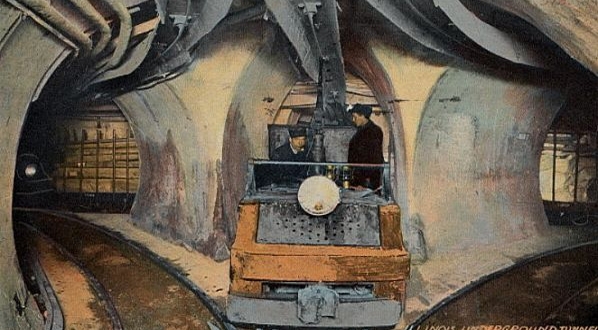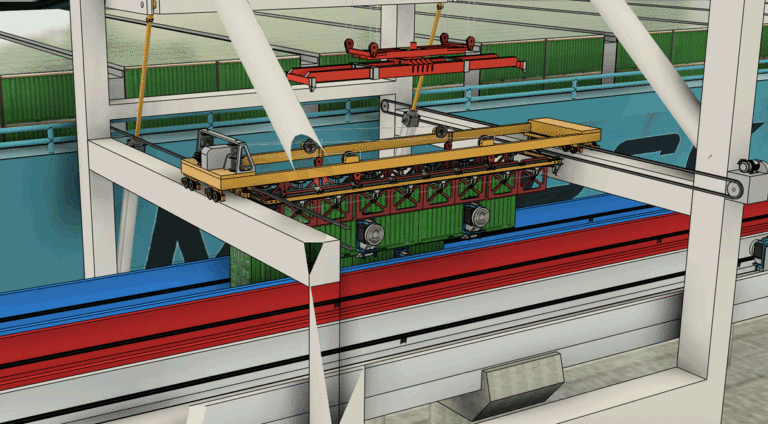History and Mission
With decades of experience in Supply-Chain Logistics, Transport Economics, and Electro-Mechanical Engineering, our founders have combined their talents to create a new paradigm for Shipping-Container transportation.
Industry Background
Using narrow tunnels for the underground transportation of freight to avoid surface congestion, is nothing new. More than a hundred years ago, such a system was deployed beneath the streets of Chicago. The thinking was sound, but the engineering was rather primitive. Today, the congestion problem remains as bad as ever, and particularly so around international ports that service shipping containers. Ports by their very nature present prime opportunities for congestion, and thus disruption to the smooth flow of container freight traffic.

Development of the international ISO specification that defined standard dimensions for shipping units, was a big step forward. The requirement was then for high-efficiency systems to transfer container-freight between ships and nearby distribution hubs, and this has been a huge challenge for most port operators. Huge investment at many of these installations has not always adequately addressed the issue.
The search continues for a cost-effective technique to seamlessly move shipping containers between rail-heads and the seaports. Multiple ‘pick up’ and ‘drop off ‘ points along the delivery path will degrade efficiency with double-handling and additional opportunities to fail. Another problem facing many port operators is the excessive amount of prime real-estate tied up for the temporary storage of containers.
Introducing CF Technologies
In 2015 the founders assembled a small team to investigate common problems faced by port operators. We had no difficulty in identifying shortcomings in systems currently deployed at ports around the world. Economics and productivity were key drivers. Was it possible to design a system for the management of shipping containers that requires less land-usage and infrastructure-capital, with lower operating-costs, than conventional technology?
We presented the results of our early research to the Australian Conference of Economists in July 2016. This led to an ongoing conversation with interested parties in both government and industry. From this point on, we expanded our research by involving the University of Melbourne and other academic institutions.

Behind the scenes, we worked tirelessly to apply new technology to the engineering challenges that had stalled the innovation process at many port facilities. Of necessity, we remained low-key when publicly detailing our technologies until the Intellectual Property was sufficiently protected. Provisional Patents have now been issued covering various unique design aspects.
Market Positioning
The CF Technologies Vision and intended Mission is to facilitate Research and Development, Economic Modelling, and Pilot Installations, with the goal of enabling efficient freight handling between container-ports and inland intermodal exchange hubs. Top priority is given to workforce safety, as well as the safety of any members of the community who could be affected by the chosen scenarios. Community interests align closely with environmentally friendly solutions, and in that regard, we aim to satisfy every possible demand.
Cost-effective, efficient outcomes for both customers and the shipping industry are also a priority for us. Productivity-gains and cost-savings flow through to benefit society as a whole. To achieve these goals without a negative impact on the environment might seem like an impossibility, but the number-crunching we have done suggests otherwise. We believe the provision and adoption of CF Technologies designs and processes can significantly reduce the total cost of freight to users throughout the world.
One of the key requirements for an efficient distribution system is that containers can flow steadily and continuously, without any scheduling restrictions. Baggage handling systems that the airlines have developed over the years have become extremely sophisticated, and there are elements of the design that would work well for containers, as long as the engineering challenges could be overcome.

In an oversimplified model, containers could be unloaded from the ship and placed on a steadily moving conveyor-belt. There are practical difficulties that would prevent the use of conveyor systems that are available today. However, the dynamics of this model align closely with the best possible scenario for freight handling.
The Way Ahead
An important consideration for freight systems is that they must integrate seamlessly and as unobtrusively as possible into the surrounding environment. With the flexible rail-architecture options offered by the CFT system, we can satisfy these requirements and minimise any negative impact on the community. It goes without saying that low noise and minimal pollution both need to be accommodated in the final solution.

To achieve our goals, we will continue reaching out to investors and incumbent logistics operators to form partnerships or collaborative joint-ventures. If your organisation fits this description, please make contact.
